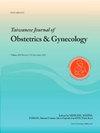Detection of chromosome 5q interstitial deletion of 5q14.3-q31.1 by chromosome microarray analysis in a second-trimester fetus with multiple congenital anomalies and a literature review of chromosome 5q interstitial deletion syndrome
IF 2
4区 医学
Q2 OBSTETRICS & GYNECOLOGY
引用次数: 0
Abstract
Objective
We present application of chromosome microarray analysis (CMA) in the detection of chromosome 5q interstitial deletion of 5q14.3-q31.1 in a second-trimester fetus with multiple congenital anomalies on fetal ultrasound.
Case Report
A 30-year-old, gravida 2, para 1, woman was found to have multiple anomalies in the fetus at 14 weeks of gestation by prenatal ultrasound screening. The fetal anomalies included echogenic bowel, a left neck cyst, hypoplastic left heart, single umbilical artery and bilateral clubfeet. The pregnancy was subsequently terminated, and a 64-g malformed fetus was delivered. CMA by array comparative genomic hybridization (aCGH) analysis on the DNA extracted from umbilical cord revealed the result of arr 5q14.3q31.1 (83,557,042–130,841,093) × 1.0 [GRCh37] with a 47.3-Mb 5q14.3-q31.1 deletion encompassing 95 OMIM genes including NR2F1, MEF2C, APC, KCNN2 and FBN2. Quantitative fluorescent polymerase chain reaction (QF-PCR) analysis on the DNA extracted from parental bloods and umbilical cord using the informative markers of D5S2496 (5q21.3) and D5S818 (5q23.2) showed that the fetus inherited only one maternal allele, indicating a paternal origin of the interstitial 5q deletion in the fetus.
Conclusion
CMA is useful for genetic investigation of unknown congenital anomalies detected by fetal ultrasound.
通过染色体微阵列分析在一名伴有多种先天性畸形的二胎胎儿中检测到 5q 染色体间质缺失(5q14.3-q31.1),以及有关 5q 染色体间质缺失综合征的文献综述
目的我们介绍了染色体微阵列分析(CMA)在一例二胎胎儿先天性畸形病例中的应用。病例报告:一名 30 岁、孕 2 期、产 1 期的妇女在妊娠 14 周时通过产前超声筛查发现胎儿有多处畸形。胎儿畸形包括回声肠、左颈囊肿、左心发育不全、单脐动脉和双侧足外翻。妊娠随后被终止,娩出了一个 64 克的畸形胎儿。通过对脐带中提取的 DNA 进行阵列比较基因组杂交(aCGH)分析,CMA 结果显示 5q14.3q31.1 (83,557,042-130,841,093) × 1.0 [GRCh37],5q14.3-q31.1 缺失 47.3 MB,包含 95 个 OMIM 基因,包括 NR2F1、MEF2C、APC、KCNN2 和 FBN2。利用信息标记 D5S2496(5q21.3)和 D5S818(5q23.2)对从父母血液和脐带中提取的 DNA 进行定量荧光聚合酶链反应(QF-PCR)分析表明,胎儿只遗传了母体的一个等位基因,表明胎儿的间质 5q 缺失来源于父方。
本文章由计算机程序翻译,如有差异,请以英文原文为准。
求助全文
约1分钟内获得全文
求助全文
来源期刊

Taiwanese Journal of Obstetrics & Gynecology
OBSTETRICS & GYNECOLOGY-
CiteScore
3.60
自引率
23.80%
发文量
207
审稿时长
4-8 weeks
期刊介绍:
Taiwanese Journal of Obstetrics and Gynecology is a peer-reviewed journal and open access publishing editorials, reviews, original articles, short communications, case reports, research letters, correspondence and letters to the editor in the field of obstetrics and gynecology.
The aims of the journal are to:
1.Publish cutting-edge, innovative and topical research that addresses screening, diagnosis, management and care in women''s health
2.Deliver evidence-based information
3.Promote the sharing of clinical experience
4.Address women-related health promotion
The journal provides comprehensive coverage of topics in obstetrics & gynecology and women''s health including maternal-fetal medicine, reproductive endocrinology/infertility, and gynecologic oncology. Taiwan Association of Obstetrics and Gynecology.
 求助内容:
求助内容: 应助结果提醒方式:
应助结果提醒方式:


